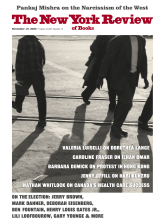The stark polarization of American politics beyond this year’s immediate health, economic, racial, and electoral legitimacy crises corresponds to sharply contrasting apocalyptic visions of the future. For those on the right the looming nightmare is demographic, namely that by 2040 white Americans will constitute a plurality but no longer a majority of the population. To prevent the emergence of a truly representative, multiracial democracy that would mean the end of “their” America, they resort to census distortion, voter suppression, gerrymandering, uncontrolled campaign financing, sharply curtailed immigration, and now even the threats to intimidate voters through “armies of poll-watchers” and to “get rid of” mail-in ballots. These measures in turn build on the systemic tilt to the right that the Constitution currently provides to red states through the Electoral College and Senate. The last line of defense of an oligarchic and illiberal republic against representative democracy is Senate Majority Leader Mitch McConnell’s stacking of the federal judiciary with very young and very conservative judges who, come the demographic tipping point, will still serve as a kind of white “house of lords” with lifetime appointments wielding veto power over unwanted legislation produced by a black-brown democratic “mob.”
For those on the left, the looming nightmare is drastic, climate-driven environmental change that will render large portions of the earth’s surface incapable of sustaining their current populations. Shrinking inhabitability in turn will lead to failed states and economies, social collapse, widespread hunger, and mass migration overwhelming borders, as well as the much-increased likelihood of the use of nuclear weapons or the spread of a pandemic with the contagiousness of Covid-19, the lethality of Ebola, and the intractability to vaccines of HIV.
Both of these future scenarios are realistic, but there is a major difference. What the right regards as a future demographic disaster simply does not fill the left with dread. Indeed, the left is not concerned about the prospect that the population of the rest of the country will come to look increasingly like California’s. The right, in contrast, shares neither the left’s fear of the effects of climate change nor even a belief in its human causation, both of which for the most part it still denies or minimizes. It must, since any practical measures would require government planning and intervention, international cooperation, and the curbing of immediate profits of powerful corporations. These are anathema to an ideology that celebrates the unfettered assertion of national sovereignty, maximum pursuit of immediate profit, and deregulation of environmental protections and other forms of government interference and “deep-state tyranny.”
Given these competing apocalyptic visions looming some two decades in the future, does the importance of the current election shrink in significance? Certainly not: what happens in this election will shape what options remain open and what options are narrowed. Four more years of Trump appointing and McConnell confirming federal judges would complete and entrench the conservative transformation of the judicial branch for decades. The imminent replacement of the late Ruth Bader Ginsburg will almost certainly marginalize the influence of the conservative institutionalist and current swing justice John Roberts, whose occasional surprise break with the conservative bloc has dismayed the right despite his consistent opposition to protecting the right to vote or reforming campaign finance, and lock in an ideologically conservative Supreme Court majority.
Four more years of Trump trampling democratic norms and purging professional civil servants and experts would leave the executive branch increasingly unchecked and ever more profoundly incompetent. Four more years of the right in power at the state level perfecting its methods of electoral manipulation could significantly expand the process by which incumbents choose who votes rather than voters choosing who governs, and only unattainable landslide margins could dislodge the party in power (as seen already, for example, in the Wisconsin and North Carolina state legislatures). The left already needs sizable margins of victory in the national popular vote to take the presidency and House of Representatives, and a veritable avalanche to win a Senate majority.
Even a narrow Trump victory would enable the right to further fortify a permanent illiberal regime capable of neutralizing the results of a demographic upheaval. Such an election outcome would also perpetuate the anti-science, anti-expert, anti-evidence, denialist approach to the threat of climate change beyond the fast-approaching point of no return, after which only the magnitude of catastrophe will still be in question. We are witnessing the predictable results of such an approach in the current pandemic, in which we have unquestionably reached the goal of “America First”—in this case, first in infections and first in deaths among all the countries on earth.
Yet the dire consequences of current denial and incompetence may be just enough to produce an electoral outcome that not only reverses the decline of American democracy and reopens the political struggle over expanded health care, social justice, income inequality, gun control, voting rights, etc., but also provides the opening for a realistic effort to cope with the threat of ecological catastrophe. In short, it is an election to keep open the hope for both American democracy and a livable planet.
Advertisement



